technical specifications FIAT IDEA 2010 1.G Owners Manual
[x] Cancel search | Manufacturer: FIAT, Model Year: 2010, Model line: IDEA, Model: FIAT IDEA 2010 1.GPages: 210, PDF Size: 4.4 MB
Page 95 of 210
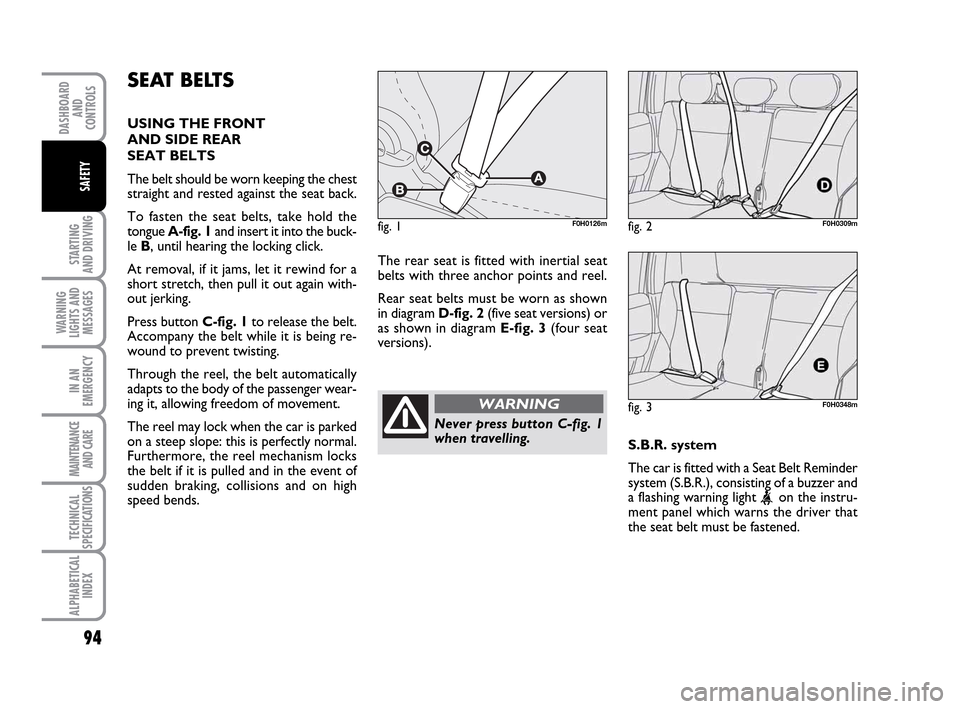
94
STARTING
AND DRIVING
WARNING
LIGHTS AND
MESSAGES
IN AN
EMERGENCY
MAINTENANCE
AND CARE
TECHNICAL
SPECIFICATIONS
ALPHABETICAL
INDEX
DASHBOARD
AND
CONTROLS
SAFETY
SEAT BELTS
USING THE FRONT
AND SIDE REAR
SEAT BELTS
The belt should be worn keeping the chest
straight and rested against the seat back.
To fasten the seat belts, take hold the
tongue A-fig. 1and insert it into the buck-
le B, until hearing the locking click.
At removal, if it jams, let it rewind for a
short stretch, then pull it out again with-
out jerking.
Press button C-fig. 1to release the belt.
Accompany the belt while it is being re-
wound to prevent twisting.
Through the reel, the belt automatically
adapts to the body of the passenger wear-
ing it, allowing freedom of movement.
The reel may lock when the car is parked
on a steep slope: this is perfectly normal.
Furthermore, the reel mechanism locks
the belt if it is pulled and in the event of
sudden braking, collisions and on high
speed bends.The rear seat is fitted with inertial seat
belts with three anchor points and reel.
Rear seat belts must be worn as shown
in diagram D-fig. 2(five seat versions) or
as shown in diagram E-fig. 3(four seat
versions).
fig. 1F0H0126mfig. 2F0H0309m
fig. 3F0H0348m
Never press button C-fig. 1
when travelling.
WARNING
S.B.R. system
The car is fitted with a Seat Belt Reminder
system (S.B.R.), consisting of a buzzer and
a flashing warning light
the seat belt must be fastened.
093-110 LUM IDEA GB 2 ed.qxd 14-01-2010 12:16 Pagina 94
Page 96 of 210
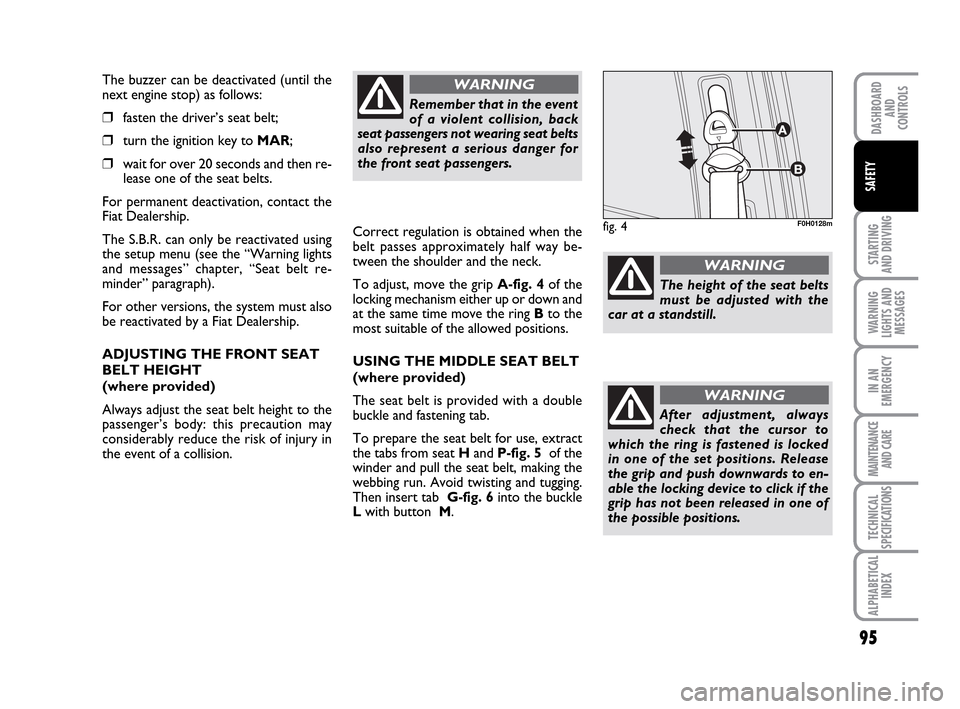
95
STARTING
AND DRIVING
WARNING
LIGHTS AND
MESSAGES
IN AN
EMERGENCY
MAINTENANCE
AND CARE
TECHNICAL
SPECIFICATIONS
ALPHABETICAL
INDEX
DASHBOARD
AND
CONTROLS
SAFETY
The buzzer can be deactivated (until the
next engine stop) as follows:
❒fasten the driver’s seat belt;
❒turn the ignition key to MAR;
❒wait for over 20 seconds and then re-
lease one of the seat belts.
For permanent deactivation, contact the
Fiat Dealership.
The S.B.R. can only be reactivated using
the setup menu (see the “Warning lights
and messages” chapter, “Seat belt re-
minder” paragraph).
For other versions, the system must also
be reactivated by a Fiat Dealership.
ADJUSTING THE FRONT SEAT
BELT HEIGHT
(where provided)
Always adjust the seat belt height to the
passenger’s body: this precaution may
considerably reduce the risk of injury in
the event of a collision. Correct regulation is obtained when the
belt passes approximately half way be-
tween the shoulder and the neck.
To adjust, move the grip A-fig. 4of the
locking mechanism either up or down and
at the same time move the ring B to the
most suitable of the allowed positions.
USING THE MIDDLE SEAT BELT
(where provided)
The seat belt is provided with a double
buckle and fastening tab.
To prepare the seat belt for use, extract
the tabs from seat H and P-fig. 5of the
winder and pull the seat belt, making the
webbing run. Avoid twisting and tugging.
Then insert tab G-fig. 6into the buckle
Lwith button M.
Remember that in the event
of a violent collision, back
seat passengers not wearing seat belts
also represent a serious danger for
the front seat passengers.
WARNING
The height of the seat belts
must be adjusted with the
car at a standstill.
WARNING
After adjustment, always
check that the cursor to
which the ring is fastened is locked
in one of the set positions. Release
the grip and push downwards to en-
able the locking device to click if the
grip has not been released in one of
the possible positions.
WARNING
fig. 4F0H0128m
093-110 LUM IDEA GB 2 ed.qxd 14-01-2010 12:16 Pagina 95
Page 97 of 210
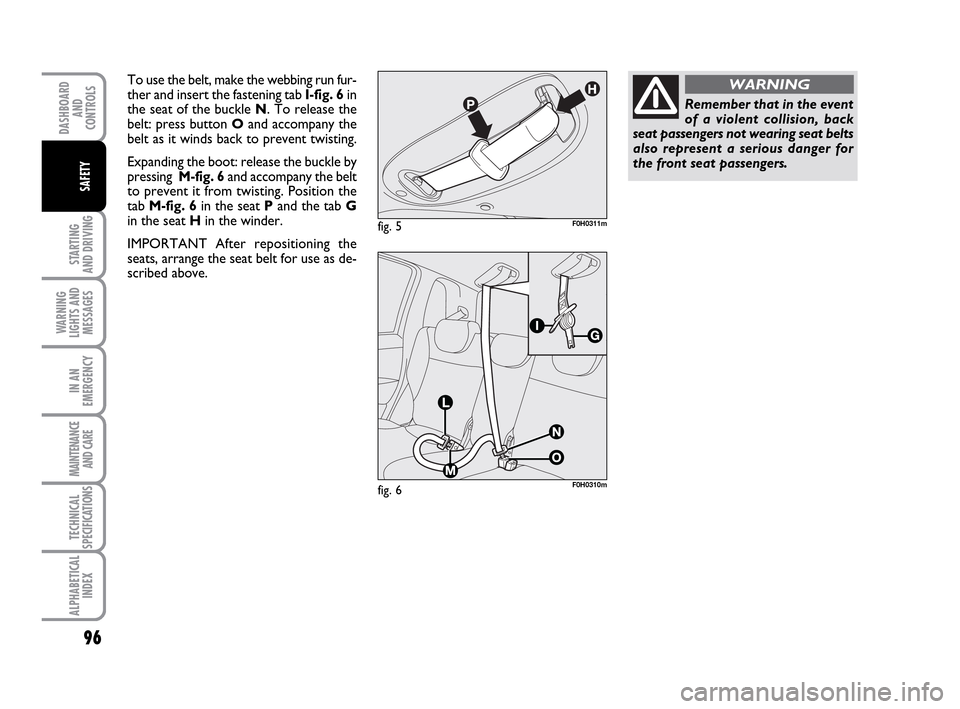
96
STARTING
AND DRIVING
WARNING
LIGHTS AND
MESSAGES
IN AN
EMERGENCY
MAINTENANCE
AND CARE
TECHNICAL
SPECIFICATIONS
ALPHABETICAL
INDEX
DASHBOARD
AND
CONTROLS
SAFETY
fig. 5F0H0311m
To use the belt, make the webbing run fur-
ther and insert the fastening tab I-fig. 6in
the seat of the buckle N. To release the
belt: press button Oand accompany the
belt as it winds back to prevent twisting.
Expanding the boot: release the buckle by
pressing M-fig. 6and accompany the belt
to prevent it from twisting. Position the
tab M-fig. 6in the seat Pand the tab G
in the seat Hin the winder.
IMPORTANT After repositioning the
seats, arrange the seat belt for use as de-
scribed above.
fig. 6F0H0310m
Remember that in the event
of a violent collision, back
seat passengers not wearing seat belts
also represent a serious danger for
the front seat passengers.
WARNING
093-110 LUM IDEA GB 2 ed.qxd 14-01-2010 12:16 Pagina 96
Page 98 of 210
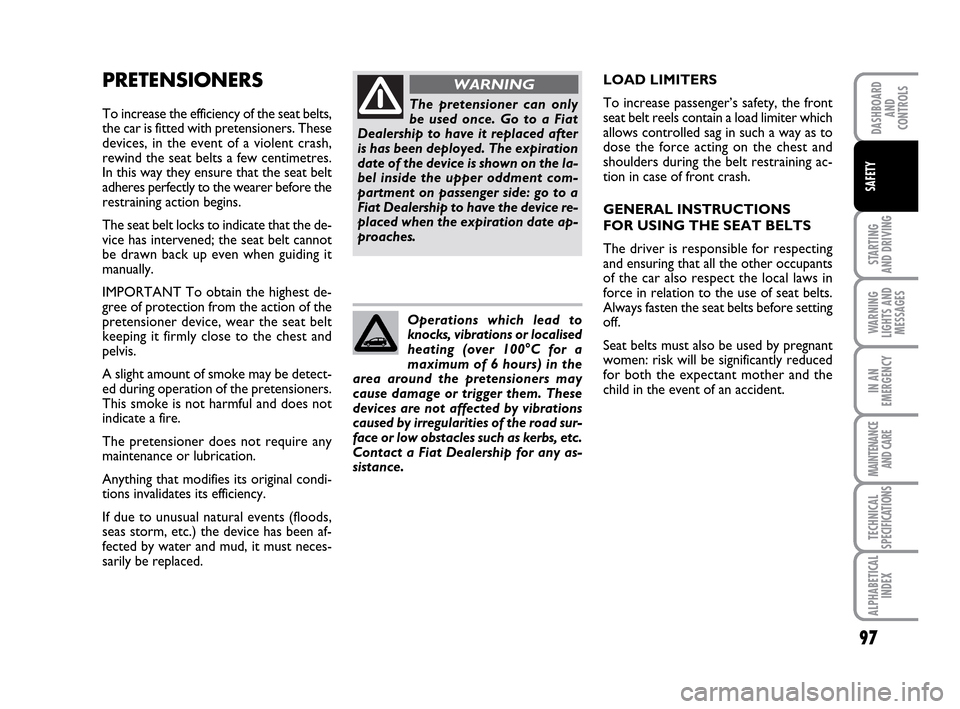
97
STARTING
AND DRIVING
WARNING
LIGHTS AND
MESSAGES
IN AN
EMERGENCY
MAINTENANCE
AND CARE
TECHNICAL
SPECIFICATIONS
ALPHABETICAL
INDEX
DASHBOARD
AND
CONTROLS
SAFETY
PRETENSIONERS
To increase the efficiency of the seat belts,
the car is fitted with pretensioners. These
devices, in the event of a violent crash,
rewind the seat belts a few centimetres.
In this way they ensure that the seat belt
adheres perfectly to the wearer before the
restraining action begins.
The seat belt locks to indicate that the de-
vice has intervened; the seat belt cannot
be drawn back up even when guiding it
manually.
IMPORTANT To obtain the highest de-
gree of protection from the action of the
pretensioner device, wear the seat belt
keeping it firmly close to the chest and
pelvis.
A slight amount of smoke may be detect-
ed during operation of the pretensioners.
This smoke is not harmful and does not
indicate a fire.
The pretensioner does not require any
maintenance or lubrication.
Anything that modifies its original condi-
tions invalidates its efficiency.
If due to unusual natural events (floods,
seas storm, etc.) the device has been af-
fected by water and mud, it must neces-
sarily be replaced.LOAD LIMITERS
To increase passenger’s safety, the front
seat belt reels contain a load limiter which
allows controlled sag in such a way as to
dose the force acting on the chest and
shoulders during the belt restraining ac-
tion in case of front crash.
GENERAL INSTRUCTIONS
FOR USING THE SEAT BELTS
The driver is responsible for respecting
and ensuring that all the other occupants
of the car also respect the local laws in
force in relation to the use of seat belts.
Always fasten the seat belts before setting
off.
Seat belts must also be used by pregnant
women: risk will be significantly reduced
for both the expectant mother and the
child in the event of an accident.The pretensioner can only
be used once. Go to a Fiat
Dealership to have it replaced after
is has been deployed. The expiration
date of the device is shown on the la-
bel inside the upper oddment com-
partment on passenger side: go to a
Fiat Dealership to have the device re-
placed when the expiration date ap-
proaches.
WARNING
Operations which lead to
knocks, vibrations or localised
heating (over 100°C for a
maximum of 6 hours) in the
area around the pretensioners may
cause damage or trigger them. These
devices are not affected by vibrations
caused by irregularities of the road sur-
face or low obstacles such as kerbs, etc.
Contact a Fiat Dealership for any as-
sistance.
093-110 LUM IDEA GB 2 ed.qxd 14-01-2010 12:16 Pagina 97
Page 99 of 210
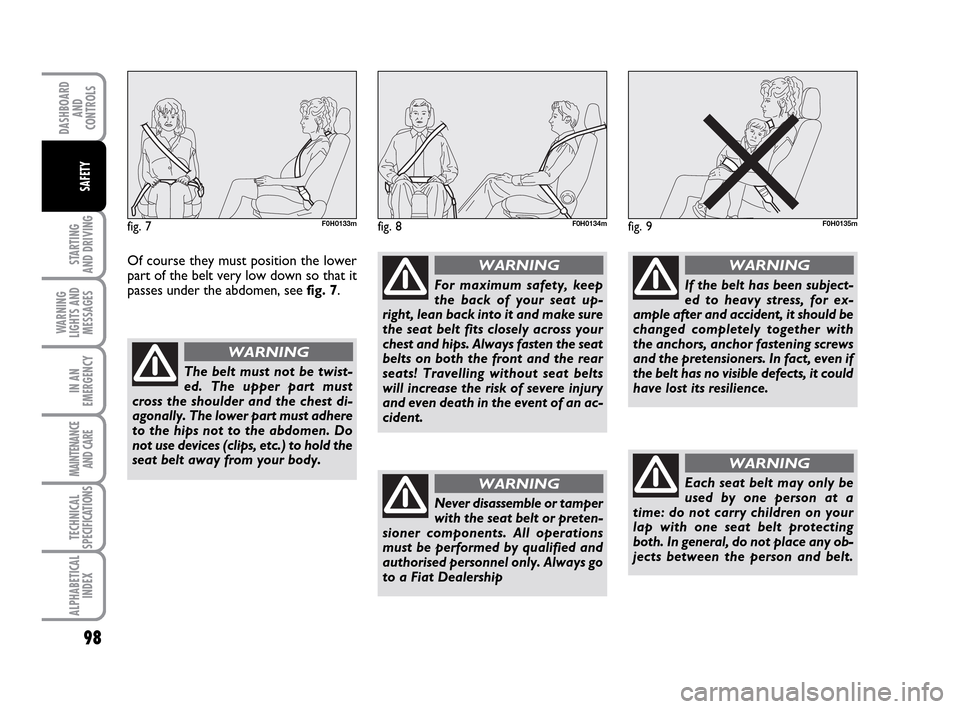
98
STARTING
AND DRIVING
WARNING
LIGHTS AND
MESSAGES
IN AN
EMERGENCY
MAINTENANCE
AND CARE
TECHNICAL
SPECIFICATIONS
ALPHABETICAL
INDEX
DASHBOARD
AND
CONTROLS
SAFETY
fig. 7F0H0133mfig. 8F0H0134mfig. 9F0H0135m
The belt must not be twist-
ed. The upper part must
cross the shoulder and the chest di-
agonally. The lower part must adhere
to the hips not to the abdomen. Do
not use devices (clips, etc.) to hold the
seat belt away from your body.
WARNING
For maximum safety, keep
the back of your seat up-
right, lean back into it and make sure
the seat belt fits closely across your
chest and hips. Always fasten the seat
belts on both the front and the rear
seats! Travelling without seat belts
will increase the risk of severe injury
and even death in the event of an ac-
cident.
WARNING
Never disassemble or tamper
with the seat belt or preten-
sioner components. All operations
must be performed by qualified and
authorised personnel only. Always go
to a Fiat Dealership
WARNING
If the belt has been subject-
ed to heavy stress, for ex-
ample after and accident, it should be
changed completely together with
the anchors, anchor fastening screws
and the pretensioners. In fact, even if
the belt has no visible defects, it could
have lost its resilience.
WARNING
Each seat belt may only be
used by one person at a
time: do not carry children on your
lap with one seat belt protecting
both. In general, do not place any ob-
jects between the person and belt.
WARNING
Of course they must position the lower
part of the belt very low down so that it
passes under the abdomen, see fig. 7.
093-110 LUM IDEA GB 2 ed.qxd 14-01-2010 12:16 Pagina 98
Page 100 of 210
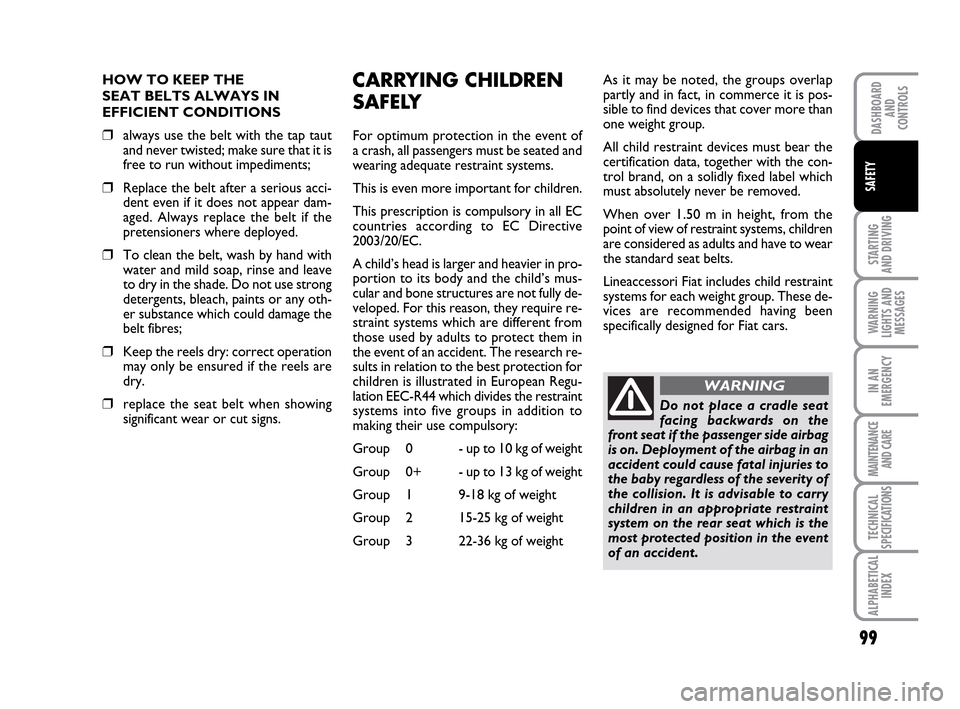
99
STARTING
AND DRIVING
WARNING
LIGHTS AND
MESSAGES
IN AN
EMERGENCY
MAINTENANCE
AND CARE
TECHNICAL
SPECIFICATIONS
ALPHABETICAL
INDEX
DASHBOARD
AND
CONTROLS
SAFETY
HOW TO KEEP THE
SEAT BELTS ALWAYS IN
EFFICIENT CONDITIONS
❒always use the belt with the tap taut
and never twisted; make sure that it is
free to run without impediments;
❒Replace the belt after a serious acci-
dent even if it does not appear dam-
aged. Always replace the belt if the
pretensioners where deployed.
❒To clean the belt, wash by hand with
water and mild soap, rinse and leave
to dry in the shade. Do not use strong
detergents, bleach, paints or any oth-
er substance which could damage the
belt fibres;
❒Keep the reels dry: correct operation
may only be ensured if the reels are
dry.
❒replace the seat belt when showing
significant wear or cut signs.
CARRYING CHILDREN
SAFELY
For optimum protection in the event of
a crash, all passengers must be seated and
wearing adequate restraint systems.
This is even more important for children.
This prescription is compulsory in all EC
countries according to EC Directive
2003/20/EC.
A child’s head is larger and heavier in pro-
portion to its body and the child’s mus-
cular and bone structures are not fully de-
veloped. For this reason, they require re-
straint systems which are different from
those used by adults to protect them in
the event of an accident. The research re-
sults in relation to the best protection for
children is illustrated in European Regu-
lation EEC-R44 which divides the restraint
systems into five groups in addition to
making their use compulsory:
Group 0 - up to 10 kg of weight
Group 0+ - up to 13 kg of weight
Group 1 9-18 kg of weight
Group 2 15-25 kg of weight
Group 3 22-36 kg of weightAs it may be noted, the groups overlap
partly and in fact, in commerce it is pos-
sible to find devices that cover more than
one weight group.
All child restraint devices must bear the
certification data, together with the con-
trol brand, on a solidly fixed label which
must absolutely never be removed.
When over 1.50 m in height, from the
point of view of restraint systems, children
are considered as adults and have to wear
the standard seat belts.
Lineaccessori Fiat includes child restraint
systems for each weight group. These de-
vices are recommended having been
specifically designed for Fiat cars.
Do not place a cradle seat
facing backwards on the
front seat if the passenger side airbag
is on. Deployment of the airbag in an
accident could cause fatal injuries to
the baby regardless of the severity of
the collision. It is advisable to carry
children in an appropriate restraint
system on the rear seat which is the
most protected position in the event
of an accident.
WARNING
093-110 LUM IDEA GB 2 ed.qxd 14-01-2010 12:16 Pagina 99
Page 101 of 210
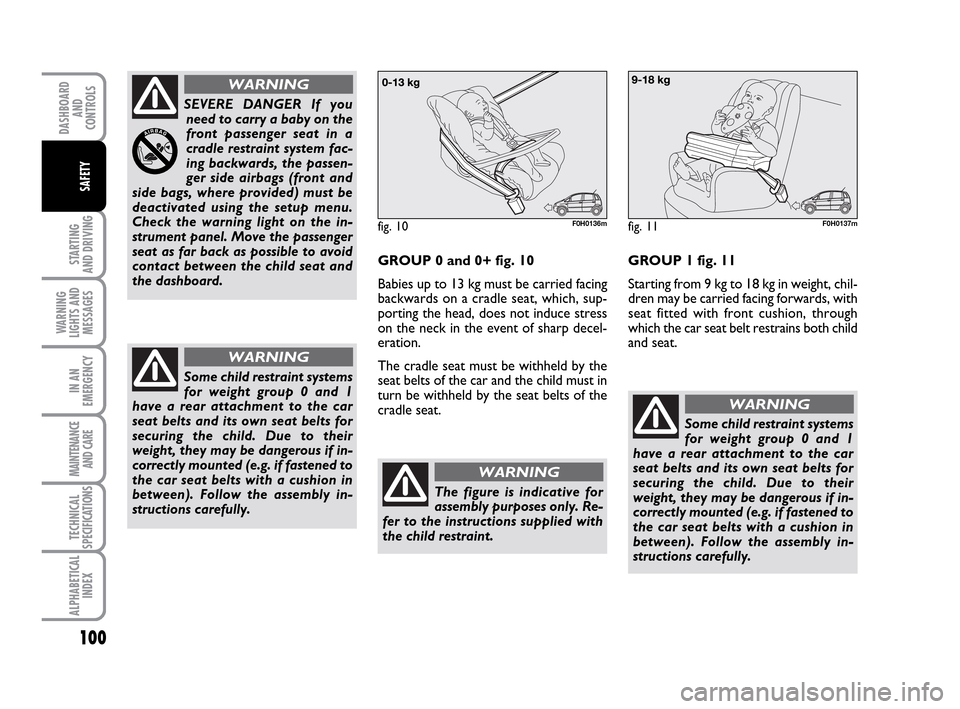
100
STARTING
AND DRIVING
WARNING
LIGHTS AND
MESSAGES
IN AN
EMERGENCY
MAINTENANCE
AND CARE
TECHNICAL
SPECIFICATIONS
ALPHABETICAL
INDEX
DASHBOARD
AND
CONTROLS
SAFETY
SEVERE DANGER If you
need to carry a baby on the
front passenger seat in a
cradle restraint system fac-
ing backwards, the passen-
ger side airbags (front and
side bags, where provided) must be
deactivated using the setup menu.
Check the warning light on the in-
strument panel. Move the passenger
seat as far back as possible to avoid
contact between the child seat and
the dashboard.
WARNING
GROUP 0 and 0+ fig. 10
Babies up to 13 kg must be carried facing
backwards on a cradle seat, which, sup-
porting the head, does not induce stress
on the neck in the event of sharp decel-
eration.
The cradle seat must be withheld by the
seat belts of the car and the child must in
turn be withheld by the seat belts of the
cradle seat.
fig. 10F0H0136m
The figure is indicative for
assembly purposes only. Re-
fer to the instructions supplied with
the child restraint.
WARNING
Some child restraint systems
for weight group 0 and 1
have a rear attachment to the car
seat belts and its own seat belts for
securing the child. Due to their
weight, they may be dangerous if in-
correctly mounted (e.g. if fastened to
the car seat belts with a cushion in
between). Follow the assembly in-
structions carefully.
WARNING
fig. 11F0H0137m
GROUP 1 fig. 11
Starting from 9 kg to 18 kg in weight, chil-
dren may be carried facing forwards, with
seat fitted with front cushion, through
which the car seat belt restrains both child
and seat.
Some child restraint systems
for weight group 0 and 1
have a rear attachment to the car
seat belts and its own seat belts for
securing the child. Due to their
weight, they may be dangerous if in-
correctly mounted (e.g. if fastened to
the car seat belts with a cushion in
between). Follow the assembly in-
structions carefully.
WARNING
093-110 LUM IDEA GB 2 ed.qxd 14-01-2010 12:16 Pagina 100
Page 102 of 210
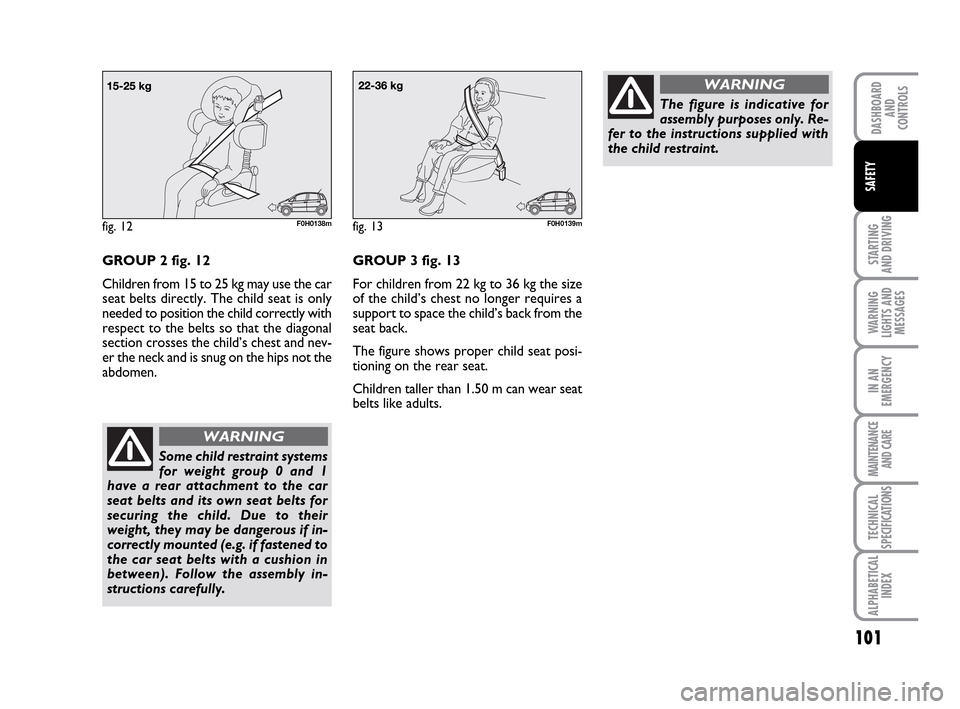
101
STARTING
AND DRIVING
WARNING
LIGHTS AND
MESSAGES
IN AN
EMERGENCY
MAINTENANCE
AND CARE
TECHNICAL
SPECIFICATIONS
ALPHABETICAL
INDEX
DASHBOARD
AND
CONTROLS
SAFETY
fig. 12F0H0138m
GROUP 2 fig. 12
Children from 15 to 25 kg may use the car
seat belts directly. The child seat is only
needed to position the child correctly with
respect to the belts so that the diagonal
section crosses the child’s chest and nev-
er the neck and is snug on the hips not the
abdomen.
Some child restraint systems
for weight group 0 and 1
have a rear attachment to the car
seat belts and its own seat belts for
securing the child. Due to their
weight, they may be dangerous if in-
correctly mounted (e.g. if fastened to
the car seat belts with a cushion in
between). Follow the assembly in-
structions carefully.
WARNING
fig. 13F0H0139m
The figure is indicative for
assembly purposes only. Re-
fer to the instructions supplied with
the child restraint.
WARNING
GROUP 3 fig. 13
For children from 22 kg to 36 kg the size
of the child’s chest no longer requires a
support to space the child’s back from the
seat back.
The figure shows proper child seat posi-
tioning on the rear seat.
Children taller than 1.50 m can wear seat
belts like adults.
093-110 LUM IDEA GB 2 ed.qxd 14-01-2010 12:16 Pagina 101
Page 103 of 210
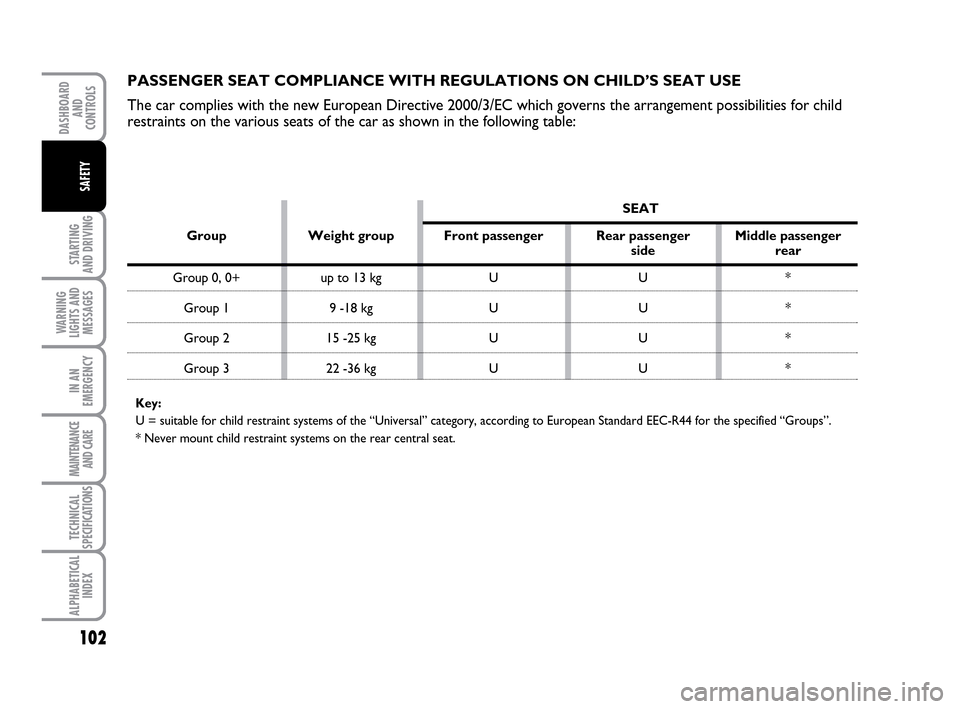
102
STARTING
AND DRIVING
WARNING
LIGHTS AND
MESSAGES
IN AN
EMERGENCY
MAINTENANCE
AND CARE
TECHNICAL
SPECIFICATIONS
ALPHABETICAL
INDEX
DASHBOARD
AND
CONTROLS
SAFETY
PASSENGER SEAT COMPLIANCE WITH REGULATIONS ON CHILD’S SEAT USE
The car complies with the new European Directive 2000/3/EC which governs the arrangement possibilities for child
restraints on the various seats of the car as shown in the following table:
SEAT
Group Weight group Front passenger Rear passenger Middle passenger
side rear
Group 0, 0+ up to 13 kg U U *
Group 1 9 -18 kg U U *
Group 2 15 -25 kg U U *
Group 3 22 -36 kg U U *
Key:
U = suitable for child restraint systems of the “Universal” category, according to European Standard EEC-R44 for the specified “Groups”.
* Never mount child restraint systems on the rear central seat.
093-110 LUM IDEA GB 2 ed.qxd 14-01-2010 12:16 Pagina 102
Page 104 of 210
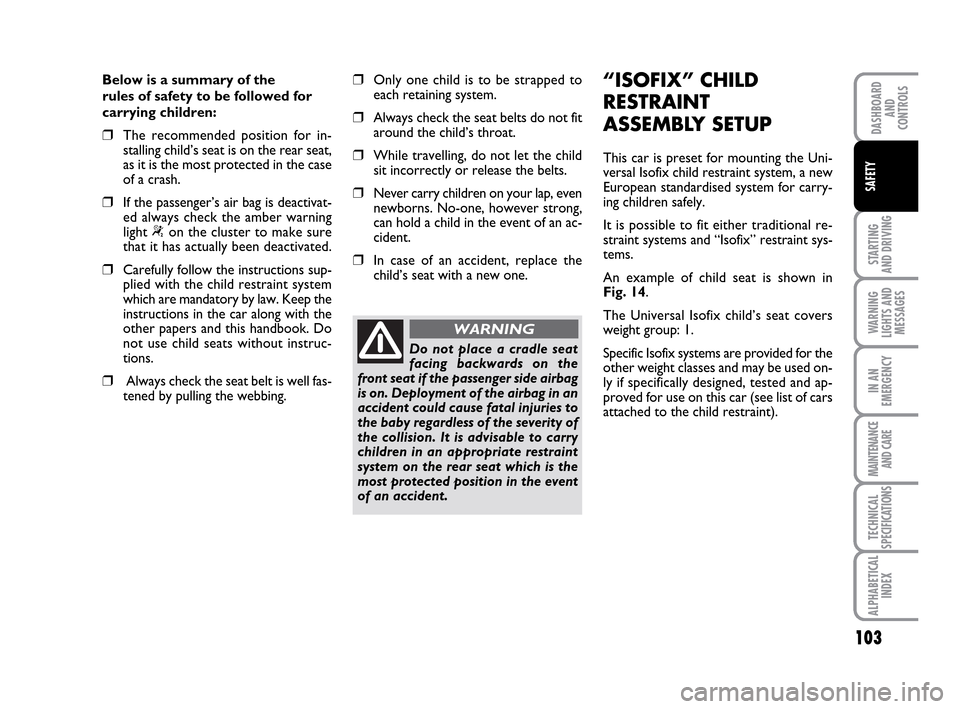
103
STARTING
AND DRIVING
WARNING
LIGHTS AND
MESSAGES
IN AN
EMERGENCY
MAINTENANCE
AND CARE
TECHNICAL
SPECIFICATIONS
ALPHABETICAL
INDEX
DASHBOARD
AND
CONTROLS
SAFETY
Below is a summary of the
rules of safety to be followed for
carrying children:
❒The recommended position for in-
stalling child’s seat is on the rear seat,
as it is the most protected in the case
of a crash.
❒If the passenger’s air bag is deactivat-
ed always check the amber warning
light “on the cluster to make sure
that it has actually been deactivated.
❒Carefully follow the instructions sup-
plied with the child restraint system
which are mandatory by law. Keep the
instructions in the car along with the
other papers and this handbook. Do
not use child seats without instruc-
tions.
❒Always check the seat belt is well fas-
tened by pulling the webbing.
❒Only one child is to be strapped to
each retaining system.
❒Always check the seat belts do not fit
around the child’s throat.
❒While travelling, do not let the child
sit incorrectly or release the belts.
❒Never carry children on your lap, even
newborns. No-one, however strong,
can hold a child in the event of an ac-
cident.
❒In case of an accident, replace the
child’s seat with a new one.
Do not place a cradle seat
facing backwards on the
front seat if the passenger side airbag
is on. Deployment of the airbag in an
accident could cause fatal injuries to
the baby regardless of the severity of
the collision. It is advisable to carry
children in an appropriate restraint
system on the rear seat which is the
most protected position in the event
of an accident.
WARNING
“ISOFIX” CHILD
RESTRAINT
ASSEMBLY SETUP
This car is preset for mounting the Uni-
versal Isofix child restraint system, a new
European standardised system for carry-
ing children safely.
It is possible to fit either traditional re-
straint systems and “Isofix” restraint sys-
tems.
An example of child seat is shown in
Fig. 14.
The Universal Isofix child’s seat covers
weight group: 1.
Specific Isofix systems are provided for the
other weight classes and may be used on-
ly if specifically designed, tested and ap-
proved for use on this car (see list of cars
attached to the child restraint).
093-110 LUM IDEA GB 2 ed.qxd 14-01-2010 12:16 Pagina 103